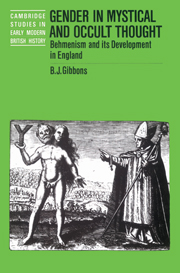Book contents
- Frontmatter
- Contents
- Acknowledgements
- 1 Introduction
- 2 Gender, sexuality and power in early modern England
- 3 Gender in mystical and occult thought
- 4 Gender in the works of Jacob Boehme
- 5 The reception of Behmenism in England
- 6 Behmenism and the Interregnum spiritualists
- 7 The female embassy
- 8 Conservative Behmenism
- 9 Wider Behmenist influences in the eighteenth century
- 10 Conclusion
- Bibliography
- Index
- Cambridge Studies in Early Modern British History
3 - Gender in mystical and occult thought
Published online by Cambridge University Press: 03 November 2009
- Frontmatter
- Contents
- Acknowledgements
- 1 Introduction
- 2 Gender, sexuality and power in early modern England
- 3 Gender in mystical and occult thought
- 4 Gender in the works of Jacob Boehme
- 5 The reception of Behmenism in England
- 6 Behmenism and the Interregnum spiritualists
- 7 The female embassy
- 8 Conservative Behmenism
- 9 Wider Behmenist influences in the eighteenth century
- 10 Conclusion
- Bibliography
- Index
- Cambridge Studies in Early Modern British History
Summary
Alongside the masculinist tradition in Judaeo-Christian theology there has always existed a counter-tradition, traces of which can be found as far back as the Old Testament writings. The triumph of Yahweh was accomplished by the assimilation of other deities, rather than their elimination. It seems likely that the divine name El Shaddai represents the incorporation of Canaanite fertility goddesses, endowing the god of the pre-Deuteronomic Jews with certain female characteristics. Although this particular tradition was suppressed by the Deuteronomic reforms, there are several passages in the Old Testament in which feminine images are applied to God, most notably in the Wisdom literature. New Testament writers tended to avoid such images, but traces of the feminisation of the deity persisted in Christian thought, especially among the Greek Fathers. Clement of Alexandria spoke of ‘the Father's loving breasts’ supplying milk to those who ‘seek the Word’. Amongst the Latin Fathers, Tertullian referred to the Holy Spirit as the Mother in the Trinity. While the use of such terms seems to have declined in the early Middle Ages, the twelfth century saw a marked revival of maternal imagery applied to God, as in the works of Bernard of Clairvaux.
Apart from this use of feminine images with regard to God, the myth of the androgyne (divine and human) has recurred throughout Judaeo-Christian thought. The duality of divine gender and the original androgyny of humanity are ancient and widespread conceptions, symbolising ‘the perfection of a primordial, non-conditioned state’.
- Type
- Chapter
- Information
- Gender in Mystical and Occult ThoughtBehmenism and its Development in England, pp. 60 - 88Publisher: Cambridge University PressPrint publication year: 1996



